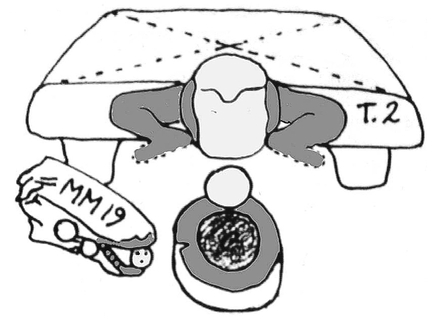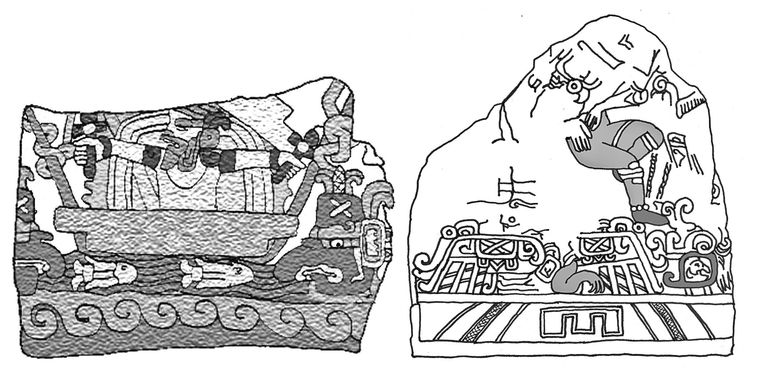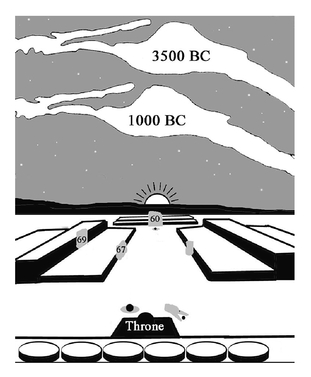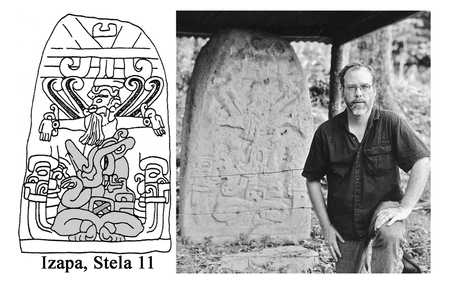The 2012 Story (23 page)
Authors: John Major Jenkins

These things are well known in Maya studies and we are firmly inside the boundaries of status quo consensus here. But what do they tell us about the astronomical symbolism of the ballgame as it was played at Izapa? First of all, the solar rebirth that the ballgame symbolizes was apparently, for the Izapans, referential to the sun’s rebirth at the December solstice. This is not at all surprising, as most ancient culture saw the December solstice as the time of the sun’s rebirth, for obvious reasons. That’s pretty neat, and tells us something about how the Izapans thought about their monuments, symbolism, and astronomy. This is a “reading” of the iconography and structural orientations at Izapa that gives meaning to the otherwise mute stones. Scholars similarly “read” or interpret hieroglyphic writing, which is an abstract form of miniature iconography. Interpreting iconographic symbolism is no less rigorous an enterprise than epigraphic interpretation; in fact, it is perhaps more rigorous because, especially at Izapa,
astronomical orientation
is an additional interpretive aid that is usually not relevant in hieroglyphic decipherment.
astronomical orientation
is an additional interpretive aid that is usually not relevant in hieroglyphic decipherment.

Throne monuments from the Izapan ballcourt. Transformation and renewal. Drawing by the author
So we can say that the ballcourt at Izapa is telling a story about the sun’s rebirth on the December solstice. But something else is going on here. As I studied the many carved monuments found in the Izapan ballcourt, a cohesive story with more profound implications unfolded. On the eastern end of the ballcourt, opposite the throne, is a monument that shows the demise of the vain and false ruler Seven Macaw. A ballplayer, probably one of the Hero Twins, is standing over him as he has crashed on the ground (see figure below). This scene represents a key episode from the Hero Twin Myth—the Hero Twins must do away with Seven Macaw, make him fall from his pride ful perch, before they can resurrect their father. This event happens at the culmination of the World Age, at the end of the cycle. The death of the false god must precede the rebirth of the true one. Importantly, we have a solar cycle at work here,
but it is much larger than an annual cycle of some 365 days
. Yes, this is a
World Age context
. The sun gets reborn every morning and every December solstice, but this rebirth happens on the level of the World Age.
but it is much larger than an annual cycle of some 365 days
. Yes, this is a
World Age context
. The sun gets reborn every morning and every December solstice, but this rebirth happens on the level of the World Age.
Earlier, we saw that the Long Count’s 13-Baktun cycle is a World Age, so we can expect that the Creation Mythology depicted in the ballcourt would have been conceptually connected to the Long Count’s cycle ending. As if to reinforce this deduction, yet another carved monument is found in the middle of the north wall of the ballcourt, halfway between the other two monuments. This is labeled Stela 67, and it contributes a key to understanding an important astronomical reference in this mytho-cosmic schema.

Stela 67 and Stela 60 from Izapa. The demise of Seven Macaw and the resurrection of One Hunahpu in the Izapan ballcourt. Drawing by the author
We see an Ahau Lord with his arms outstretched, holding what appear to be scepters of rulership or perhaps sighting devices. He doesn’t represent a historical figure, but rather a mythological archetype—the First Father deity who partitions and measures the cosmos at the dawn of a World Age. The arms-outstretched gesture, according to Maya scholars who have studied Izapa’s symbolism, is a “period-ending” gesture and testifies to this interpretation. He is seated or standing in the middle of a canoe. Maya scholars have noted that canoes in which Creation deities ride represent the Milky Way. Stela 67 is located in
the middle
of the ballcourt, and ballcourts were also symbols of the Milky Way. Here we have several different and accepted interlocking readings of the canoe symbol, connecting it meaningfully to the ballcourt and the Milky Way. Ballcourts were also evocative of earth depressions, entrances into the underworld where the Creation Mythology was to be played out. The “entrance to the underworld” concept is centrally important in the
Popol Vuh
Creation Mythology, and is explicitly associated with the feature along the Milky Way called “the dark rift.” Since the canoe is analogous to both the ballcourt and the Milky Way, then the seating declivity of the canoe in which the reborn solar lord stands or sits is most likely the dark rift in the Milky Way. There is no other feature along the Milky Way that fits the required function. This makes sense because the solar lord isn’t simply sitting or standing, he is being born, at the dawn of a new World Age.
the middle
of the ballcourt, and ballcourts were also symbols of the Milky Way. Here we have several different and accepted interlocking readings of the canoe symbol, connecting it meaningfully to the ballcourt and the Milky Way. Ballcourts were also evocative of earth depressions, entrances into the underworld where the Creation Mythology was to be played out. The “entrance to the underworld” concept is centrally important in the
Popol Vuh
Creation Mythology, and is explicitly associated with the feature along the Milky Way called “the dark rift.” Since the canoe is analogous to both the ballcourt and the Milky Way, then the seating declivity of the canoe in which the reborn solar lord stands or sits is most likely the dark rift in the Milky Way. There is no other feature along the Milky Way that fits the required function. This makes sense because the solar lord isn’t simply sitting or standing, he is being born, at the dawn of a new World Age.
I’ve been referring to this character anonymously, but we can identify him as One Hunahpu, the father of the Hero Twins. His head also emerges from between the legs on the nearby throne, and he is reborn after Seven Macaw falls, as depicted on the east-end monument. And remember, that reborn solar head on the throne points toward the December solstice rebirth. My argument for the astronomical identity of the Hero Twins’ father as the December solstice sun is especially relevant and evident right here in the Izapan ballcourt. We don’t know what might have occurred to this original, primordial identification later on in Maya history, as the original concepts evolved and were perhaps forgotten. Sometimes, the solar rebirth of the ballgame was elsewhere connected to the spring equinox sun. The point is that here, at Izapa, at the very origins of this astro-theological paradigm, the solar rebirth of the ballgame and the rebirth of the solar father of the Hero Twins is without doubt connected to the December solstice. The rebirth takes place through many symbols in these monuments—the goal ring, the throne legs, the canoe seat, but they are all referential to one celestial location, the dark rift in the Milky Way. The emphasis on World Age rebirth at the December solstice is, of course, meaningful and compelling in reference to the 13-Baktun cycle’s December solstice placement, when the December solstice sun will be positioned in the dark rift in the Milky Way.

The Izapan ballcourt, oriented to the December solstice sunrise and the future galactic alignment
This deduction gains support when we actually look at what was happening over the solstice horizon some 2,100 years ago, when the ballgame’s mystery play was being enacted on this “ballcourt of creation.”
We should expect that the ballgame was played on the December solstice, as that is the day indicated by the ballcourt’s orientation and is thus the locus of the ceremonial act of solar rebirth. In the predawn skies of a typical December solstice at Izapa some 2,100 years ago, the Milky Way could be seen arching some 30° above the dawning sun. Right there, in the middle of the Milky Way canoe, could be seen the dark rift in the Milky Way, the celestial “portal to the otherworld,” the next World Age. Deeply interwoven symbolism connects the “portal, doorway, maw” opening to the birthplace archetype. One Hunahpu’s resurrection is through this dark rift, as the game ball goes through the goal ring. How this symbolism can be read in the sky is the connection point to 2012: The future resurrection of One Hunahpu, the birth of a new era, occurs when the December solstice sun aligns with the dark rift in the Milky Way.
Their awareness of this future alignment requires that the Izapans knew about the precessional shifting. We know that the earlier Olmec at La Venta and the people at nearby Tak’alik Ab’aj were aware of precession.
33
Izapa encodes a cosmology associated with this future convergence. They knew it would happen, as the positions of the solstice sun and the dark rift slowly drew closer. It may have taken some time to perfect the Long Count system and target the 13-Baktun cycle’s end date on the future alignment accurately, but they easily could have deduced the general direction of the motion long before that “materialization of time.”
34
33
Izapa encodes a cosmology associated with this future convergence. They knew it would happen, as the positions of the solstice sun and the dark rift slowly drew closer. It may have taken some time to perfect the Long Count system and target the 13-Baktun cycle’s end date on the future alignment accurately, but they easily could have deduced the general direction of the motion long before that “materialization of time.”
34
T
he section above presents the bare bones of my reconstruction work. A slightly expanded consideration of additional evidence at Izapa follows. I mentioned earlier that my first indication that the carved monuments of Izapa were going to provide evidence for an awareness of the galactic alignment came from Stela 11. There are two main symbols on this monument: the frog’s mouth and the human figure that is emerging from it. Here we can benefit from definitions that come to us from epigraphers, where the upturned frog-mouth glyph means “to be born.” It is likely that hieroglyphic writing, developed after Izapa’s monuments were carved, evolved into more abstract shorthand forms from the earlier pictorial presentations, such as the one on Stela 11. The figure in the frog’s mouth on this carving is much like the one on Stela 67, displaying the “arms outstretched” gesture that scholars identify as a “period-ending” sign. He is the primordial first solar lord, the First Father deity who measures the cosmos at the dawn of an Age. He represents the Sun or Era that is newly born, emerging from the “to be born” place that is the frog’s mouth. Maya birthing concepts envision the newborn coming into the earth realm from the underworld. The frog’s mouth is thus the portal to the underworld.
he section above presents the bare bones of my reconstruction work. A slightly expanded consideration of additional evidence at Izapa follows. I mentioned earlier that my first indication that the carved monuments of Izapa were going to provide evidence for an awareness of the galactic alignment came from Stela 11. There are two main symbols on this monument: the frog’s mouth and the human figure that is emerging from it. Here we can benefit from definitions that come to us from epigraphers, where the upturned frog-mouth glyph means “to be born.” It is likely that hieroglyphic writing, developed after Izapa’s monuments were carved, evolved into more abstract shorthand forms from the earlier pictorial presentations, such as the one on Stela 11. The figure in the frog’s mouth on this carving is much like the one on Stela 67, displaying the “arms outstretched” gesture that scholars identify as a “period-ending” sign. He is the primordial first solar lord, the First Father deity who measures the cosmos at the dawn of an Age. He represents the Sun or Era that is newly born, emerging from the “to be born” place that is the frog’s mouth. Maya birthing concepts envision the newborn coming into the earth realm from the underworld. The frog’s mouth is thus the portal to the underworld.

The author with Stela 11, Izapa. December 2006
Other carvings at Izapa testify to frogs, caimans, and alligators’ being symbols of the Milky Way, and their mouths are the dark rift. This belongs to a near-universal symbology in Mesoamerican religion, where even among the latter-day Aztecs the cloud serpent, Mixcoatl, symbolized the Milky Way and its mouth was the dark rift.
35
We can thus deduce with good confidence that the frog’s mouth on Stela 11 represents the dark rift in the Milky Way. The carving, by the way, faces the December solstice sunrise horizon, over which the dark rift could be viewed some 2,100 years ago. This circumstance also helps us interpret the astronomical identity of the first solar lord that is born from the mouth. In the same way that the solar head on the throne in the ballcourt represents the December solstice sun because it faces down the lengthwise axis of the ballcourt toward the December solstice sunrise, so too the Stela 11 solar lord represents the December solstice sun. This is elementary yet striking in its implications: Stela 11 depicts the December solstice sun being reborn from the dark rift in the Milky Way. It doesn’t state the date in hieroglyphic terms or with a Long Count date, but it points to era-2012 via an astronomical image-complex. We will see that this isn’t the only time that a strategy of referring to a precession-specific era solely with iconography was employed by the ancient Maya.
35
We can thus deduce with good confidence that the frog’s mouth on Stela 11 represents the dark rift in the Milky Way. The carving, by the way, faces the December solstice sunrise horizon, over which the dark rift could be viewed some 2,100 years ago. This circumstance also helps us interpret the astronomical identity of the first solar lord that is born from the mouth. In the same way that the solar head on the throne in the ballcourt represents the December solstice sun because it faces down the lengthwise axis of the ballcourt toward the December solstice sunrise, so too the Stela 11 solar lord represents the December solstice sun. This is elementary yet striking in its implications: Stela 11 depicts the December solstice sun being reborn from the dark rift in the Milky Way. It doesn’t state the date in hieroglyphic terms or with a Long Count date, but it points to era-2012 via an astronomical image-complex. We will see that this isn’t the only time that a strategy of referring to a precession-specific era solely with iconography was employed by the ancient Maya.
Other books
Femme Fatale by Carole Nelson Douglas
Nebula Awards Showcase 2010 by Bill Fawcett
The Pleasure of Bedding a Baroness by Lejeune, Tamara
Protecting What's His by Tessa Bailey
A Fine Mess by Kristy K. James
Summoning Shadows: A Rosso Lussuria Vampire Novel by Pennington, Winter
Devoted to the Bear by T. S. Joyce
Scandal's Reward by Jean R. Ewing
Dracula Unleashed by Linda Mercury
Blood Hunter (The Grandor Descendant Series) by Stoires, Bell